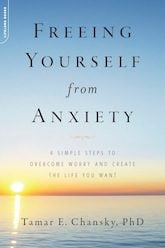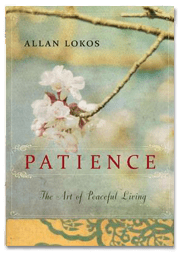Do we know anyone without it?
I mean, yes, some people don’t admit to having it. But it is assumed these days that if you have a pulse, you have anxiety.
One of my best teachers on this topic is Tamar Chansky, a clinical psychologist and one of the nation’s leading experts on anxiety disorders. She is the acclaimed author of several books, including “Freeing Your Child from Anxiety,” and the founder and director of the Children’s and Adult Center for OCD and Anxiety.
I am a huge fan of her work. I think I was introduced to it by my therapist, when I was terrified that my son would end up with a brain like mine. And then, through blogging, I came to know Dr. Chansky on a personal level, and she has impressed me even more so, because she communicates in a language I can understand! It’s great!
Her first few books were geared toward children’s anxiety and negative thoughts, but the same wisdom she offers for kids works for adults too. In fact, I have always applied her kids’ advice to me. Now I don’t feel embarrassed about that! Because this month she has come out with her first book for adults, which I have found incredibly helpful: “Freeing Yourself from Anxiety.”
So it is my honor to interview her for my readers. Please check out her book if you are struggling with anxiety or know someone who is.
1. Why are we all so anxious? Is it just a product of modern life, or is there something we can do about it?
There’s a quote I came across while writing the book that said, “It’s not that the news has gotten worse; it’s that the reporting has gotten so much better.” Our general anxiety level has risen as a culture, in part due to recent events in history. For example, the recession, the events of 9/11, and the news- and media-saturated lives we lead keep our pulse running a little higher as we practice imagining disaster on a daily basis. That starts to spill over to daily life, and it takes less to get us very stressed. That’s why there has never been a more important time for all of us to learn ways of lowering our baseline level of anxiety.
2. These strategies seem interesting for everyday worries, but what if someone is facing cancer or a layoff—can these strategies really apply?
Absolutely. What’s so interesting about anxiety is that regardless of the actual magnitude of the problem we’re contemplating, the mechanisms of anxiety are the same—we focus all of our attention on the most extreme or unlikely scenarios, leaving us feeling helpless to take any steps to help ourselves. So especially when readers are facing actual challenges, they need these strategies more so that they can stop wasting precious time and emotional energy rehearsing some future disaster that won’t likely occur, and can use those valuable resources on their behalf right now.
3. You talk about distinguishing between the “worry story” and the “story of your life.” That makes it seems like our lives are “made up.” What do you mean by that?
The events in our lives—the triumphs and struggles—are not made up. But the narrative or the story we tell ourselves about them—whether we read them as opportunities or insurmountable conditions or even dead ends—that’s up to us. There are always options. As consumers, we would never accept the “first offer” from a car salesperson or feel compelled to buy the first thing we see at a store. Similarly, people need to learn how not to fall for their first take on a situation, understanding that such gut reactions come from the fast but inaccurate survival-oriented brain. Instead, they can learn to set the “worry story” aside and reach for other more adaptive, accurate, and useful interpretations and angles on what’s actually happening in their lives.

4. Your subtitle mentions four steps. What are they, and how are they used?
Worry gets its power from operating stealth, taking much more authority than it warrants merely by the powerful sounds and statements it makes. Step one, Using Your Caller ID, means relabeling or stamping the thought with the appropriate tag—determining if it’s 1-800-Worry-Me talking to you or your trusted Voice of Reason. Step two, Getting Specific, means taking the overwhelming first impression of the problem and narrowing it down to the real risk or matter at hand. Step three, Optimizing, means not giving up but backing up and getting perspective; now that you’ve narrowed down the problem, call in experts or other perspectives to give their take on the situation. Step four, Mobilizing, means getting moving; you’ve defined the problem and see your options—and now you can go from theory to practice and start making changes in your life.
5. You say that we can “save ourselves the trip” when it comes to worry. What do you mean by that?
Worry is a detour off the track of what we need to do, and it generally isn’t a helpful one. Worry is notoriously unreliable, exaggerated, and distorted. Truly it’s exactly the things we don’t need to worry about. Rather than go miles down that road of unlikely scenarios and having to reassure ourselves back from the edge of the cliff, if we immediately recognize the sound of worry—the oh no’s, the what if’s—and respond instead with you again or the like, we can save ourselves from having to go to the edge and back every time a worry comes up.
6. What if people have been worriers all their lives? Can they really change?
The short answer is yes. Neuroplasticity is the idea that the brain is constantly changing and adapting in response to our activities. Look how we’ve all learned to type as a result of email and texting. The brain gets busy with whatever it’s used to so, yes, for some of us we’ve gotten used to worrying—we’re experts. At the same time, as we learn to devalue the importance of worry, even see it as detrimental, rather than thinking that it’s an important part of being “prepared” or “in control,” we can start to change our reaction. We can switch gears over to rational thinking. It feels much better. In time, as we change our reaction, the brain learns how to do that too. This adaptive response in the face of uncertainty or fear becomes the new default reaction so we don’t have to work as hard to find it. Rational thinking or our voice of reason is now on our speed dial.


